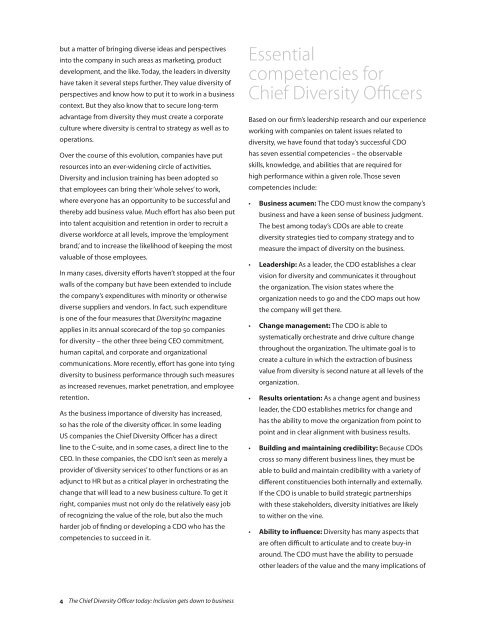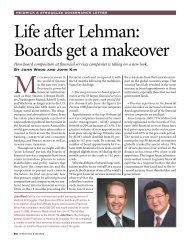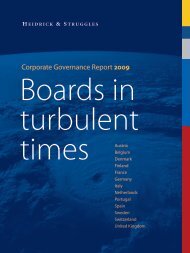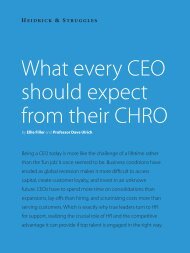The Chief Diversity Officer today - Heidrick & Struggles
The Chief Diversity Officer today - Heidrick & Struggles
The Chief Diversity Officer today - Heidrick & Struggles
Create successful ePaper yourself
Turn your PDF publications into a flip-book with our unique Google optimized e-Paper software.
ut a matter of bringing diverse ideas and perspectives<br />
into the company in such areas as marketing, product<br />
development, and the like. Today, the leaders in diversity<br />
have taken it several steps further. <strong>The</strong>y value diversity of<br />
perspectives and know how to put it to work in a business<br />
context. But they also know that to secure long-term<br />
advantage from diversity they must create a corporate<br />
culture where diversity is central to strategy as well as to<br />
operations.<br />
Over the course of this evolution, companies have put<br />
resources into an ever-widening circle of activities.<br />
<strong>Diversity</strong> and inclusion training has been adopted so<br />
that employees can bring their ‘whole selves’ to work,<br />
where everyone has an opportunity to be successful and<br />
thereby add business value. Much effort has also been put<br />
into talent acquisition and retention in order to recruit a<br />
diverse workforce at all levels, improve the ‘employment<br />
brand,’ and to increase the likelihood of keeping the most<br />
valuable of those employees.<br />
In many cases, diversity efforts haven’t stopped at the four<br />
walls of the company but have been extended to include<br />
the company’s expenditures with minority or otherwise<br />
diverse suppliers and vendors. In fact, such expenditure<br />
is one of the four measures that <strong>Diversity</strong>Inc magazine<br />
applies in its annual scorecard of the top 50 companies<br />
for diversity – the other three being CEO commitment,<br />
human capital, and corporate and organizational<br />
communications. More recently, effort has gone into tying<br />
diversity to business performance through such measures<br />
as increased revenues, market penetration, and employee<br />
retention.<br />
As the business importance of diversity has increased,<br />
so has the role of the diversity officer. In some leading<br />
US companies the <strong>Chief</strong> <strong>Diversity</strong> <strong>Officer</strong> has a direct<br />
line to the C-suite, and in some cases, a direct line to the<br />
CEO. In these companies, the CDO isn’t seen as merely a<br />
provider of ‘diversity services’ to other functions or as an<br />
adjunct to HR but as a critical player in orchestrating the<br />
change that will lead to a new business culture. To get it<br />
right, companies must not only do the relatively easy job<br />
of recognizing the value of the role, but also the much<br />
harder job of finding or developing a CDO who has the<br />
competencies to succeed in it.<br />
4 <strong>The</strong> <strong>Chief</strong> <strong>Diversity</strong> <strong>Officer</strong> <strong>today</strong>: Inclusion gets down to business<br />
Essential<br />
competencies for<br />
<strong>Chief</strong> <strong>Diversity</strong> <strong>Officer</strong>s<br />
Based on our firm’s leadership research and our experience<br />
working with companies on talent issues related to<br />
diversity, we have found that <strong>today</strong>’s successful CDO<br />
has seven essential competencies – the observable<br />
skills, knowledge, and abilities that are required for<br />
high performance within a given role. Those seven<br />
competencies include:<br />
• Business acumen: <strong>The</strong> CDO must know the company’s<br />
business and have a keen sense of business judgment.<br />
<strong>The</strong> best among <strong>today</strong>’s CDOs are able to create<br />
diversity strategies tied to company strategy and to<br />
measure the impact of diversity on the business.<br />
• Leadership: As a leader, the CDO establishes a clear<br />
vision for diversity and communicates it throughout<br />
the organization. <strong>The</strong> vision states where the<br />
organization needs to go and the CDO maps out how<br />
the company will get there.<br />
• Change management: <strong>The</strong> CDO is able to<br />
systematically orchestrate and drive culture change<br />
throughout the organization. <strong>The</strong> ultimate goal is to<br />
create a culture in which the extraction of business<br />
value from diversity is second nature at all levels of the<br />
organization.<br />
• Results orientation: As a change agent and business<br />
leader, the CDO establishes metrics for change and<br />
has the ability to move the organization from point to<br />
point and in clear alignment with business results.<br />
• Building and maintaining credibility: Because CDOs<br />
cross so many different business lines, they must be<br />
able to build and maintain credibility with a variety of<br />
different constituencies both internally and externally.<br />
If the CDO is unable to build strategic partnerships<br />
with these stakeholders, diversity initiatives are likely<br />
to wither on the vine.<br />
• Ability to influence: <strong>Diversity</strong> has many aspects that<br />
are often difficult to articulate and to create buy-in<br />
around. <strong>The</strong> CDO must have the ability to persuade<br />
other leaders of the value and the many implications of
















